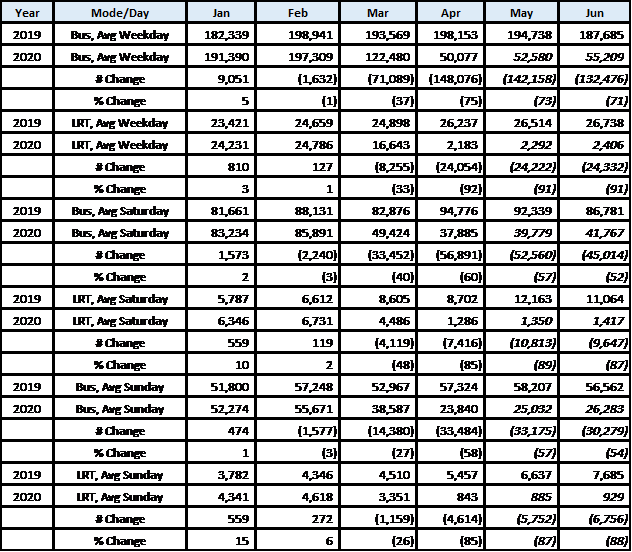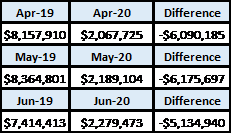Summary: Port Authority (PAAC) data shows falling transit ridership due to the coronavirus and economic shutdown. Despite a service reduction, PAAC did not furlough any employees and its preliminary budget for the next fiscal year envisions a higher headcount. Given financial resources will be even more scarce in the new fiscal year, steps must be taken to make the authority more cost-effective.
In mid-March as the economic shutdown began and businesses closed, a stay-at-home and social-distancing order was implemented, PAAC reduced weekday service by 25 percent. In April, PAAC limited the number of riders on vehicles.
How was ridership affected? PAAC’s performance metrics and system data tool displays average ridership data on bus and light rail for weekdays, Saturdays and Sundays back to January 2018. In March 2020, average weekday bus ridership was 122,480. That was down 37 percent from March 2019. April was even more pronounced. Average weekday ridership was 50,077, down 75 percent from April 2019.
Light rail fell at a similar rate in March 2020. Average weekday ridership was 16,643; the prior March it was 24,898, a 33 percent decline year-over-year. April was far worse: average weekday ridership was 2,183, down 92 percent from the prior April average of 26,237.
Much, but not all, of PAAC’s weekday service was restored on May 18. Beginning in June additional operational changes including the collection of cash fares on buses, a practice that was temporarily suspended, will be made. If averages for April increase by 5 percent in May and by 5 percent in June PAAC will be looking at average ridership numbers of anywhere from 52 percent to 91 percent lower than the same month in 2019.
What did the decline in ridership mean for fare revenue collected from passengers? Information presented to PAAC’s finance committee in April showed March 2020 passenger revenue (bus, light rail and incline) was $5.9 million. This was $1.3 million (18 percent) lower than the March 2019 actual of $7.2 million. The impact on April’s revenues will be even more significant given the steeper decrease in ridership and riders getting refunds on passes.
By using 2018 National Transit Database (NTD) values for fare revenues and unlinked trips by mode and the ridership data from PAAC, it is estimated that April’s bus and light-rail passenger revenue fell from $8.1 million to $2.1 million year-over-year. Similar losses for May ($6.2 million) and June ($5.1 million) are estimated year-over-year. The changes in average ridership through April and estimates for May and June along with estimated revenue impacts are contained in tables at the end of this Brief.
Even with the decline in passenger revenue and uncertainty about ridership going forward, PAAC’s preliminary operating budget for the fiscal year that begins July 1 is higher than the adopted budget for this year and adds employees.
Presented to the finance committee in May, the budget would be $23.5 million higher than the budget for FY 2019-20. It would have $104.2 million in operating income, which would be $1.2 million lower than what was budgeted for this year. Passenger revenue is expected to be down by $1.2 million from $78.3 million to $77.1 million.
Total expenses would rise and wages and salaries and pensions and employee benefits would be nearly equal at $180 million each. Not only will PAAC and its largest labor union have to agree to a new contract after the current pact expires at the end of June but the preliminary budget anticipates 79 new hires at a time when businesses are furloughing or laying off employees and are operating far below normal staff levels. Only three expense categories—materials and supplies, purchased services and utilities—are projected to decline.
The subsidy portion could be much different. That is due to the effects of the coronavirus on other governments that provide PAAC’s subsidy but also a share of $25 billion in federal transit infrastructure grants to urban and rural agencies from the CARES Act.
The Federal Transit Administration (FTA) website shows $162 million granted to the Pittsburgh “urbanized area”; news articles have stated PAAC would receive $141 million. In PAAC’s current operating budget the federal subsidy is budgeted at $39.2 million.
The FTA awarded the money based on existing transit formulas. It did not distribute the money based on bus operating cost per revenue hour. The 2018 NTD report on the largest 50 transit agencies shows just five topped PAAC’s $188.43.
State money could be affected by the decrease in Pennsylvania Turnpike traffic and sales taxes. Allegheny County levies on alcoholic drinks and vehicle rentals will most likely drop. An annual grant from the Regional Asset District (RAD) will decline as the RAD board announced in late May that all grant recipients would see a 20 percent cut. PAAC received $225,000 per month from January to April for a 2020 operating grant of $3 million. The monthly amount going forward would be $180,000. County and RAD monies provide the match for state dollars.
PAAC’s board was reformed in 2013 to have a mixture of state and county appointees. Now is the time for those appointees to make it very clear that state and county revenue sources will be more limited and an hurting and an increase in the PAAC budget or new employees is not realistic in this time of uncertainty and high private sector unemployment. If additional manpower is needed there is always contracting to outside vendors. Even the state passed an interim budget that expires in November.
If the effects of the business shutdown continue for some time, that could have a significant effect on PAAC ridership. If businesses don’t reopen or allow more people to work from home, if universities and the Pittsburgh Public Schools don’t hold in-person classes and if sporting events don’t resume, all that will have a serious impact on ridership and revenue, meaning next year’s budget will have to be revisited.
As we have said for years, the Port Authority of Allegheny County is much too costly and inefficient. Now is the perfect time to examine all aspects of operations and move toward being a more cost-effective system to best serve the riders and taxpayers.
Actual and Estimated Ridership, 2019 and 2020 (estimates in italics)

Estimated Passenger Revenue Impact for Remainder of Fiscal Year


